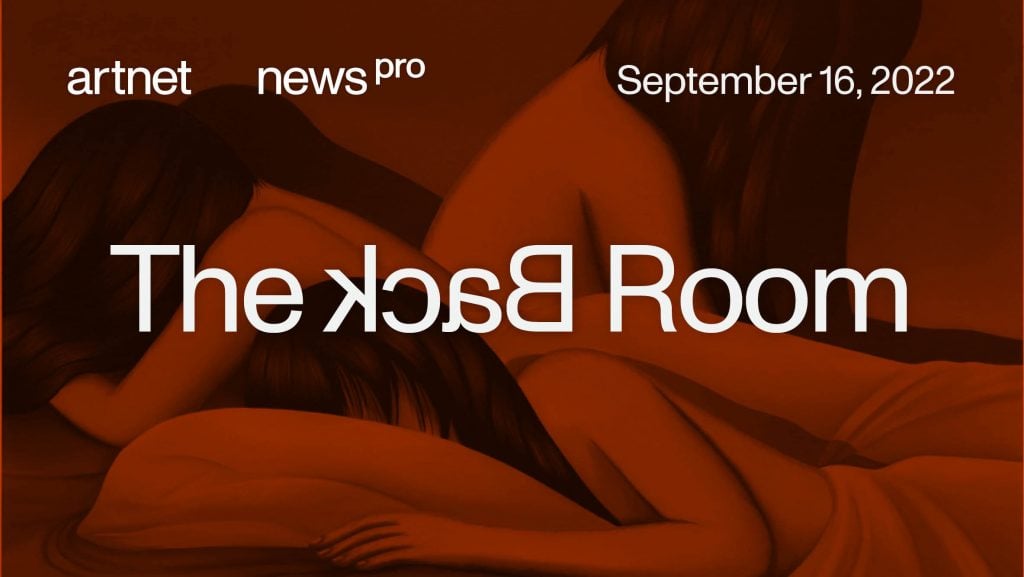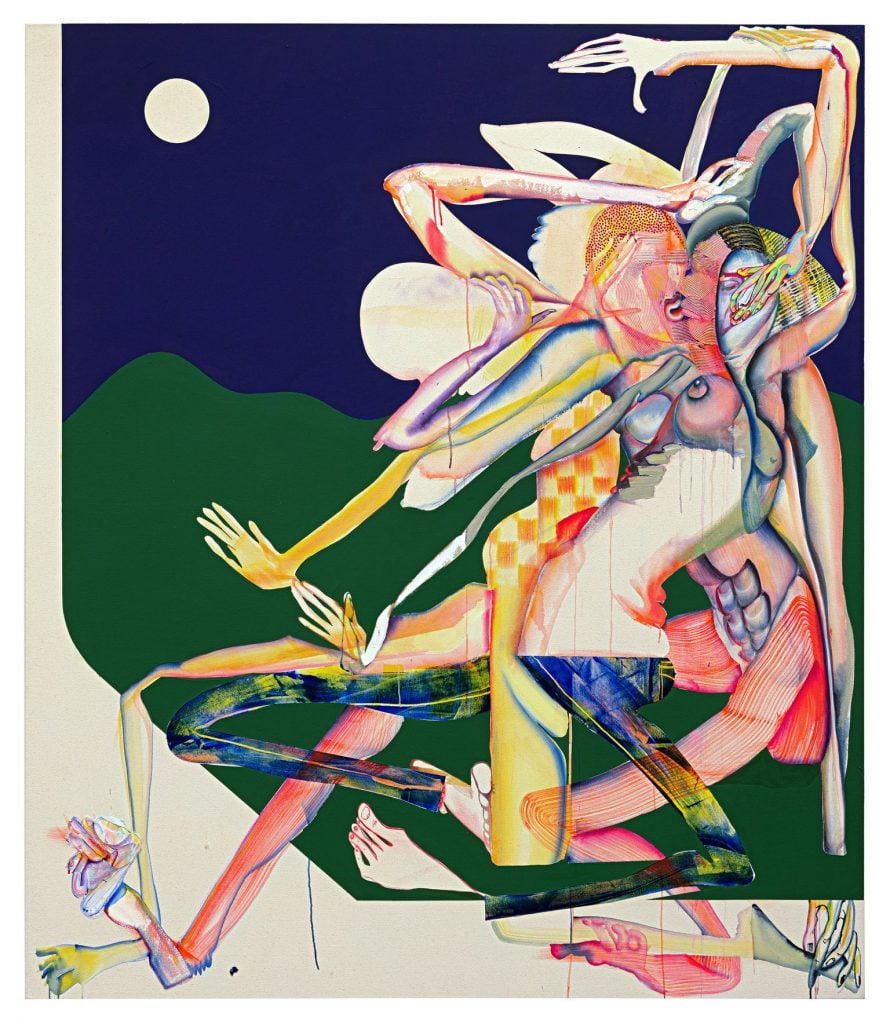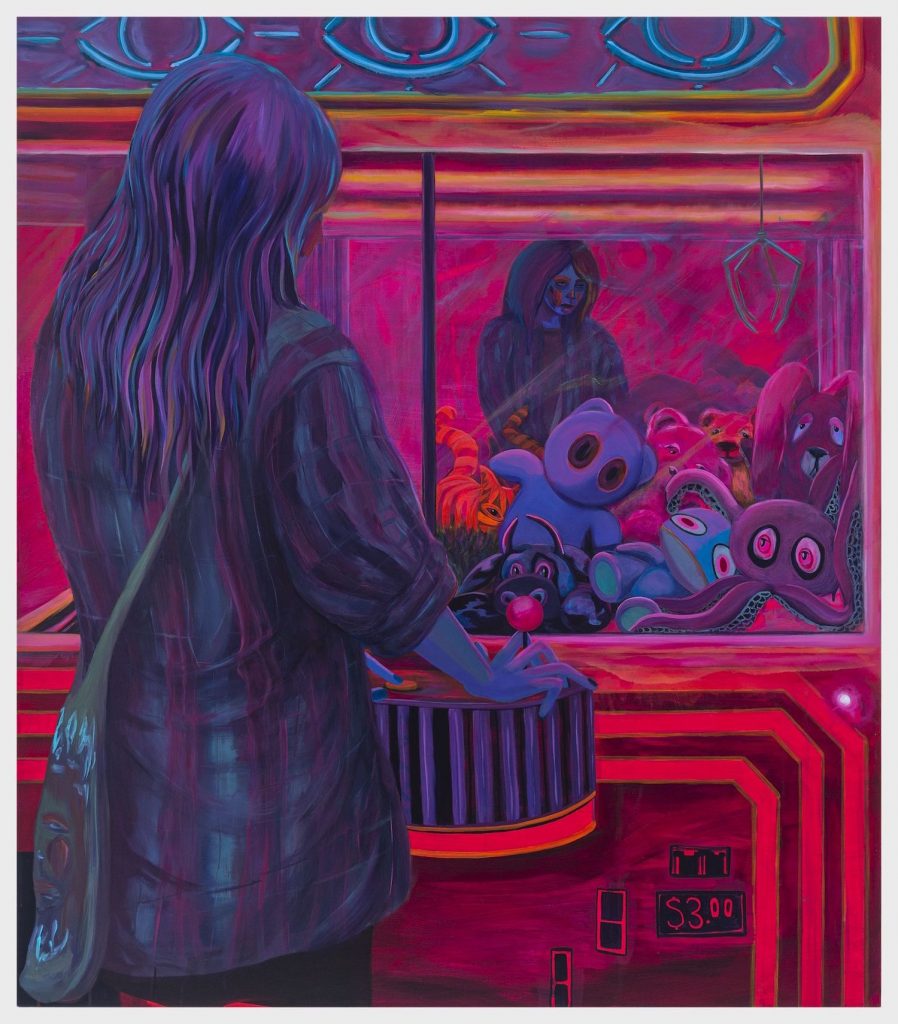The Back Room
The Back Room: Surreal Season
This week: Surrealism surrounds us, art theft meets auto theft, the rise of Danielle Roberts, and much more.

This week: Surrealism surrounds us, art theft meets auto theft, the rise of Danielle Roberts, and much more.

Tim Schneider &
Naomi Rea

Every Friday, Artnet News Pro members get exclusive access to the Back Room, our lively recap funneling only the week’s must-know intel into a nimble read you’ll actually enjoy.
This week in the Back Room: Surrealism surrounds us, art theft meets auto theft, the rise of Danielle Roberts, and much more—all in a 6-minute read (1,774 words).
__________________________________________________________________________

Christina Quarles, The Night That Fell Upon Us Up On Us (2019). Courtesy of Sotheby’s.
If life in the art world lately has left you feeling like the partition between your conscious and unconscious minds is crumbling, it isn’t just accumulated stress. Across sectors, price bands, and artistic demographics, Surrealism is back.
Katya wove the threads together on Wednesday, writing that the style’s presence during Armory Week “felt hot in a way it hasn’t for a while, and covered segments of the market ranging from ultra-contemporary to historic. And when it came to prices, those felt pretty surreal, too.”
In aesthetics and asking price, the high priestess of the new Surrealism may be 37-year-old Christina Quarles. While some of her paintings hang in Cecelia Alemani’s feminist take on the Surrealists’ legacy in the Venice Biennale, new works in Quarles’s current show at Hauser and Wirth in New York are priced as high as $1.2 million. That’s nearly twice the artist’s auction record last fall ($685,500)… but only a small fraction of her auction record today ($4.5 million).
Quarles stands out among living artists, but the crowd she emerged from is substantial and growing. Below, a cross-section of the types of artists driving the Surrealist revival during New York’s fall art season…
The inaugural edition of Independent 20th Century featured multiple artists who worked from the movement’s core principles but outside its traditional spotlight.
Prototypical Artist: Stanislao Lepri (1905–80), an Italian whose imagery of anthropomorphic animals (his alter ego was the rhino) has risen in the wake of escalating demand for works by his lover, path-breaking Surrealist Leonor Fini. By the fair’s end, Tommaso Calabro gallery from Milan reported 10 sales of Lepri’s works, with asking prices ranging from $40,000 to $70,000. (Katya did a separate dive into Lepri here.)
Similar Artists Offered Last Week: Gertrude Abercrombie (1909–77), a Midwestern American Surrealist whose $300,000 diptych was placed by Corbett vs. Dempsey gallery.
Market Angle: Value, as dealers and collectors invested in Modernism watch prices for contemporary Surrealists blast off into the millions.
Across New York’s contemporary-focused fairs, a new generation explored Surrealist themes at prices often topping out at $10,000.
Prototypical Artist: Megan Bogonovich, who filled the booth of Vermont’s Kishka Gallery and Library at Spring/Break with 100 pint-sized porcelain forms hybridizing the human, the floral, and the alien. At $700 to $1,200 each, her works found buyers early and often.
Similar Artists Offered Last Week: Chang Ya Chin (b. 1985), a Hong Kong-born painter whose miniature canvases sold well in Half Gallery’s presentation at the Armory Show.
Market Angle: Potential, as speculators take low-cost fliers on the prospect of quick but healthy returns.
With René Magritte’s $79.4 million L’empire des lumières (1961) still beating all other Impressionist and Modern works at auction YTD, canonical Surrealists are ascendant, too.
Prototypical Artist: Joan Miró, whose minimalist Surrealism was the subject of the debut exhibition at Luxembourg and Co., the new gallery of veteran dealer Daniella Luxembourg and her daughter Alma Luxembourg. Pieces for sale range from $3 million to $9 million, and two are insured for more than $20 million, per a gallery spokesperson.
Similar Artists Offered Last Week: Surrealist movement cofounder André Breton, sometimes-Surrealist Francis Picabia, and proto-Surrealist Giorgio de Chirico all had works sold at Independent 20th Century.
Market Angle: Endurance, as the style’s current surge reinforces that its early proponents can be relied on as relatively safe stores of value.
Ultra-contemporary artists who earned rabid fans with Surrealist-influenced works a few years ago are returning to the scene stronger and more mature.
Prototypical Artist: Julie Curtiss (b. 1982), whose lightly eerie, face-phobic works could be pitched as Magritte for millennials. Curtiss opened an already-sold-out show of drawings, paintings, and sculptures at Anton Kern last week. Prices ranged from $22,000 to $250,000—a far cry from the $6,000 ceiling on paintings in her debut gallery show at 106 Green just five years ago.
Similar Artists Offered Last Week: Loie Hollowell (b. 1983), whose mystical abstractions are bending back toward their Surrealist origins in new work reflecting on motherhood and the body. (A drawing titled Fully Dilated went for $60,000 in Jessica Silverman’s Armory booth.)
Market Angle: The Goldilocks Zone, as buyers pay a premium for growing legitimacy while still getting in before a possible Quarles-like leap into the millions on the primary market.
__________________________________________________________________________
Even some dealers benefiting from the Surrealism revival argue that the movement’s name is being applied too liberally to works by ultra-contemporary artists. “These days, it’s a catchall for a particular style of representational painting—very often, it’s figuration with a twist,” Katya wrote. It might be fairer to call its practitioners Surreal-ish rather than Surrealist.
Yet even faint links to the uncanny, the unconscious, and the automatic are powering up demand for a range of inventory by artists living and dead. The surge won’t last forever. For now, though, it’s electrifying nearly all corners of the market—so either plan for it, or plan around it.
____________________________________________________________________________

Rick Rubin thanking his lucky stars. Photo by Frazer Harrison/Getty Images for Spotify.
The latest Wet Paint tracks the evidence that Def Jam Records cofounder and god-level music producer Rick Rubin is the owner of a recently incinerated home in Marfa once owned by Donald Judd. (Thankfully, no one was hurt in the blaze, and there were no signs of foul play.)
Plus, artist Jillian Mayer’s newest project, a conceptual artwork inside a 20-foot trailer with roughly $20,000 in customizations, appears to have been stolen less than three months out from its scheduled debut during Art Basel Miami Beach. She is now offering a reward for its return.
Here’s what else made a mark around the industry since last Friday morning…
Art Fairs
Auction Houses
Galleries
Institutions
NFTs and More
____________________________________________________________________________
“I find it disturbing, quite frankly, that increasingly the artists who are being shown in major galleries are figurative artists painting, drawing, and producing Black figures. Only this time it’s being determined by galleries—white galleries.”
—Pioneering dealer Linda Goode Bryant, the Black founder and director of Just Above Midtown gallery from 1974–86, in a wide-ranging interview. (Artnet News)
____________________________________________________________________________

Danielle Roberts, Out of Reach (2022). Image courtesy the artist and Fredericks and Freiser.
____________________________________________________________________________
Price Range: $6,500 to $18,000
Sold to: Herb and Lenore Schorr
Sold at: The Armory Show
Among our artists to watch from Armory Week was Danielle Roberts, a recent graduate of the MFA program at Hunter College whose cool, violet-dominated compositions are heating up the art world.
While her distinctive color palette “definitely has brought her attention,” according to namesake dealer Andy Freiser of New York gallery Fredericks and Freiser, the deeper draw is its role in helping Roberts create a compelling “fusion of youth culture and themes of disaffection and alienation.”
The cocktail proved powerful at the Armory Show, as Fredericks and Freiser swiftly found buyers for two new Roberts paintings in its booth. One of them, Out of Reach, was acquired by major Princeton University Art Museum donors Herb and Lenore Schorr. The Schorrs bolster a stable of early Roberts supporters that Freiser already labeled “top tier,” including Wexner Center for the Arts and Columbus Museum of Art trustee Pete Scantland, as well as the Ashti Foundation in Lebanon.
Roberts was recently featured in the group exhibition “Women of Now” at the Green Family Foundation in Dallas and held a solo show at San Francisco gallery Friends Indeed. Her first one-person exhibition at Fredericks and Freiser is set for February 2023. How much further her violet star will have risen by then is anyone’s guess.
____________________________________________________________________________